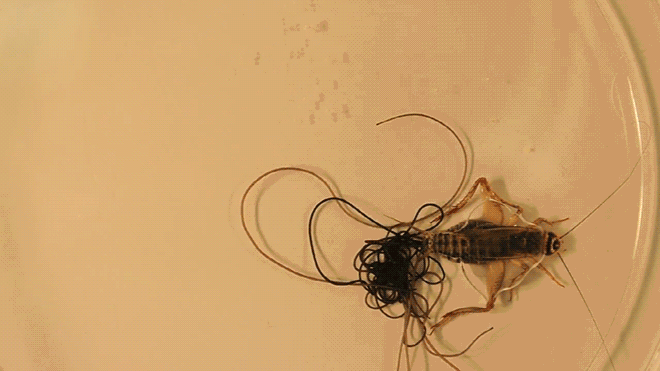Welcome Back!!!
Earlier I mentioned the fact that hairworms cause their hosts to commit suicide unwillingly so that they can continue their life cycle and reproduce. Here’s why and how they do such.
These worms can grow up to a foot long, but to get to that point, it needs a house cricket or grasshopper to be its host to do such growth. (Jones 2015).
In the picture below you will see that once in, the hairworm coerces the insect into the nearest body of water as opposed to running away from it. (Jones 2015)

(Source: http://www.bbc.com/earth/story/20150316-ten-parasites-that-control-minds)
First, a tiny horsehair worm larva is eaten by the larva of another insect, such as a mosquito or mayfly. Once this emerges from the water, a cricket or grasshopper will snatch it up. Then the horsehair worm begins to develop inside the insect (Jones 2015).
This isn’t the end; the worm’s final stage of development takes place in water. The cricket wouldn’t normally swim, or even hang out near water, so the worm must figure out a way to get into the water while growing in the host. (Jones 2015).
By altering the functions of the cricket’s nervous system, the cricket jumps into the water and drowns itself, allowing the horsehair worm to emerge and reproduce for a repeated cycle. (Jones 2015).
With regards to the hairworm proteome reaction during the expression of the water-seeking behavior by the host, many of the identified proteins are linked to protein biosynthesis (pC, pD, pP, pA1), to the release and secretion of neurotransmitter (pA, pG), to functions on the CNS (pB, pG, pI, pM, pQ, pY), and to endopeptidase inhibition (pZ)(Biron et. al 2005).
Biron and his group of researchers observed that the parasite produced ‘host-like’ proteins, illustrating a case of a molecular mimicry (Salzet et al. 2000; Taylor et al. 2004). More specifically, an overproduction of two proteins (pQ and pY) acting directly in the development of the CNS. (Biron et. al 2005).
MALDI-TOF signals suggest that these two proteins are synthesized by hairworms but are mimetic to proteins observed in the class Insecta (Biron et. al 2005).
From the outside, you wouldn’t be able to tell if a cricket had been infected, but neurologically, the worm is in control (Jones 2015).
This form of mimicry allows the host insect to be infected without realization of the being taken over. The hairworm can call the shots while the host believes they are acting on their own instinct.

(Source: https://www.wired.com/2014/05/absurd-creature-horsehair-worm/)
Citations:
Jones, L. (2015). Earth – Ten sinister parasites that control their hosts’ minds. http://www.bbc.com/earth/story/20150316-ten-parasites-that-control-minds.
D. G. Biron, L. Marche, F. Ponton, H. D. Loxdale, N. Gale´otti,L. Renault, C. Joly and F. Thomas (2005). Behavioural manipulation in a grasshopper harbouring hairworm: a proteomics approach. doi:10.1098/rspb.2005.3213
 (
( (
(